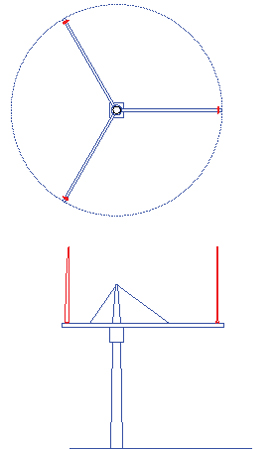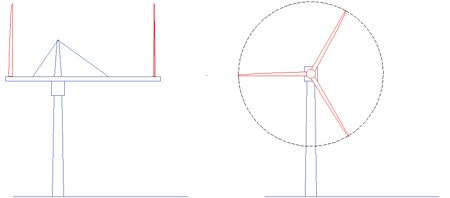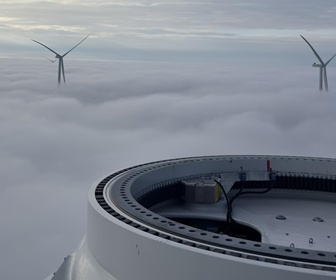 Tremendous progress can be observed in wind turbines and their technology development, as demonstrated by the increase in their size and power capture capability. The growth in size, however, cannot be indefinite and eventually reaches a limit, from a practicality viewpoint. All newer generations of current wind turbines from almost all manufacturers in the past 40+ years have been based on improving the previous generation as well as making them larger. This is true except for a few models that could not survive or even could not enter the market, for whatever reason.
Tremendous progress can be observed in wind turbines and their technology development, as demonstrated by the increase in their size and power capture capability. The growth in size, however, cannot be indefinite and eventually reaches a limit, from a practicality viewpoint. All newer generations of current wind turbines from almost all manufacturers in the past 40+ years have been based on improving the previous generation as well as making them larger. This is true except for a few models that could not survive or even could not enter the market, for whatever reason.By Ahmad Hemami, McGill University, Montreal, Canada
Having said that, much of the research and development work has been focused on horizontal axis wind turbines (HAWTs), and the little research on vertical axis wind turbines (VAWTs) has been mainly by research institutions and not for-profit establishments. This, also, can be justified since R&D is costly and for a manufacturer it is more reasonable to focus on the betterment of a product with which it has experience rather than deviating to activities with unpredictable and uncertain results as well as unpromised clients.
On the other hand, despite the fact that initially the (lift base) VAWTs have shown some weak points (in early research), like not being sufficiently controllable if they get to overspeed (Darrieus turbine), they have advantages over HAWTs. It cannot be denied that, putting safety first, the drawback of a lack of ability to stop a turbine is significant.
Putting all these facts together, rational thinking can lead to combining the two types of turbine to benefit from the advantages of both, while eliminating the drawbacks. A HAWT needs to be yawed into the wind, which introduces additional cost in both manufacturing and maintenance, plus the uncertainty of performing this action with enough accuracy and the extra stress that can be forced on certain components during the yaw operation. In addition, the turbine body is subject to thrust forces that push the turbine in the wind direction. In the case of offshore turbines, this can cause some oscillation towards and away from the wind, which is not desirable and can cause a cyclic change in the wind speed reaching the turbine. It is logical to resolve all these issues by not needing to yaw a turbine. And that is when the VAWT steps in.
 Referring to a VAWT is not just referring to the Darrieus turbine, the blades of which cannot (or are difficult to) pitch. A variation of the H-rotor, with three straight, vertical blades that can be pitched, as shown in Figure 1, suggests various advantages over a HAWT of comparable size, as depicted in Figure 2. This H-rotor variation turbine has the following characteristics:
Referring to a VAWT is not just referring to the Darrieus turbine, the blades of which cannot (or are difficult to) pitch. A variation of the H-rotor, with three straight, vertical blades that can be pitched, as shown in Figure 1, suggests various advantages over a HAWT of comparable size, as depicted in Figure 2. This H-rotor variation turbine has the following characteristics:
- It uses blades that are similar to those of a HAWT, with the advantage that they do not have a twist and are thus easier to manufacture. Furthermore, because of zero twist there is no need to optimise the twist for the range of operating wind speeds (more uniformity with wind speed change).
- The blades are mounted at the end of a horizontal support. For the same size (length) blades, the length of the support is about 1.5 times the blade length (to have the same power output). This gives a relatively better distance between the blades, thus reducing the effect on the downwind blade from the upwind blade vortex.
- The tower is the same height as in the comparable HAWT in order to benefit from the higher wind speed.
- The nacelle is beneath the horizontal support and it does not turn.
The advantages associated with the design are:
- No need for yaw motion.
- Blades can be pitched as in a HAWT and there is full control of adjusting their rotational speed and bringing a turbine to a halt.
- More stable offshore turbines with floating foundation.
- There is also a hidden advantage. If the horizontal support (or part of it) is made such that it can generate an upward lift when rotating, then part of the weight of the rotor can be lifted off the bearings between the rotor and the tower.
Further Reading
Hand, B. and Cashman, A. 2018. Aerodynamic modeling methods for a large-scale vertical axis wind turbine: a comparative study. Renewable Energy Part A v129, pp. 12–31.
Hand, B. and Cashman, A. 2018. Aerodynamic modeling methods for a large-scale vertical axis wind turbine: a comparative study. Renewable Energy Part A v129, pp. 12–31.










